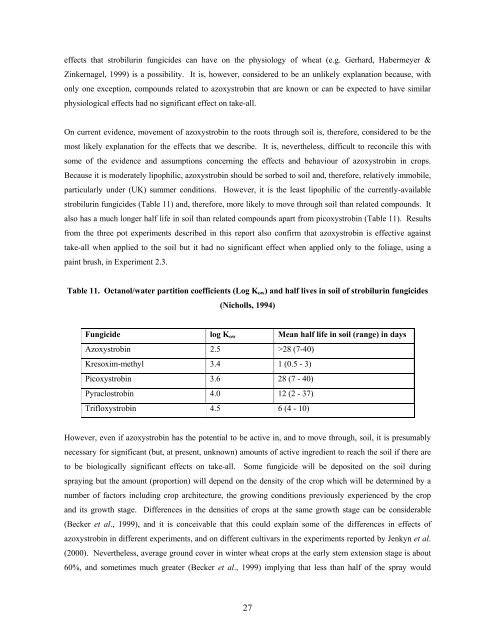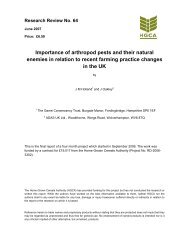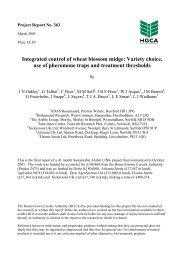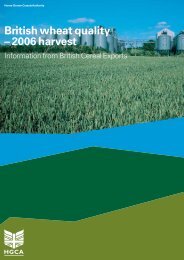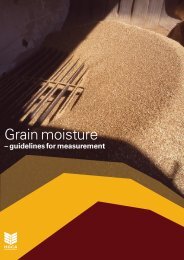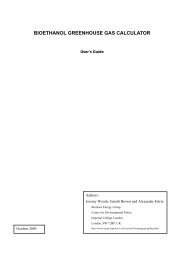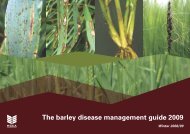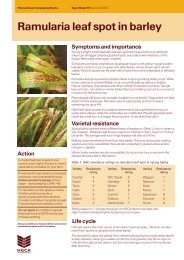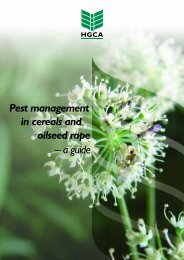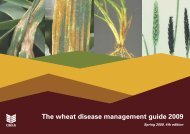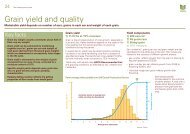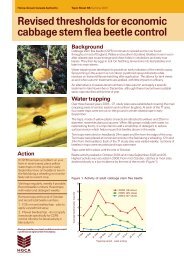PROJECT REPORT No. 285 EFFECTS OF ... - HGCA
PROJECT REPORT No. 285 EFFECTS OF ... - HGCA
PROJECT REPORT No. 285 EFFECTS OF ... - HGCA
- No tags were found...
You also want an ePaper? Increase the reach of your titles
YUMPU automatically turns print PDFs into web optimized ePapers that Google loves.
effects that strobilurin fungicides can have on the physiology of wheat (e.g. Gerhard, Habermeyer &Zinkernagel, 1999) is a possibility. It is, however, considered to be an unlikely explanation because, withonly one exception, compounds related to azoxystrobin that are known or can be expected to have similarphysiological effects had no significant effect on take-all.On current evidence, movement of azoxystrobin to the roots through soil is, therefore, considered to be themost likely explanation for the effects that we describe. It is, nevertheless, difficult to reconcile this withsome of the evidence and assumptions concerning the effects and behaviour of azoxystrobin in crops.Because it is moderately lipophilic, azoxystrobin should be sorbed to soil and, therefore, relatively immobile,particularly under (UK) summer conditions. However, it is the least lipophilic of the currently-availablestrobilurin fungicides (Table 11) and, therefore, more likely to move through soil than related compounds. Italso has a much longer half life in soil than related compounds apart from picoxystrobin (Table 11). Resultsfrom the three pot experiments described in this report also confirm that azoxystrobin is effective againsttake-all when applied to the soil but it had no significant effect when applied only to the foliage, using apaint brush, in Experiment 2.3.Table 11. Octanol/water partition coefficients (Log K ow ) and half lives in soil of strobilurin fungicides(Nicholls, 1994)Fungicide log K ow Mean half life in soil (range) in daysAzoxystrobin 2.5 >28 (7-40)Kresoxim-methyl 3.4 1 (0.5 - 3)Picoxystrobin 3.6 28 (7 - 40)Pyraclostrobin 4.0 12 (2 - 37)Trifloxystrobin 4.5 6 (4 - 10)However, even if azoxystrobin has the potential to be active in, and to move through, soil, it is presumablynecessary for significant (but, at present, unknown) amounts of active ingredient to reach the soil if there areto be biologically significant effects on take-all. Some fungicide will be deposited on the soil duringspraying but the amount (proportion) will depend on the density of the crop which will be determined by anumber of factors including crop architecture, the growing conditions previously experienced by the cropand its growth stage. Differences in the densities of crops at the same growth stage can be considerable(Becker et al., 1999), and it is conceivable that this could explain some of the differences in effects ofazoxystrobin in different experiments, and on different cultivars in the experiments reported by Jenkyn et al.(2000). Nevertheless, average ground cover in winter wheat crops at the early stem extension stage is about60%, and sometimes much greater (Becker et al., 1999) implying that less than half of the spray would27


